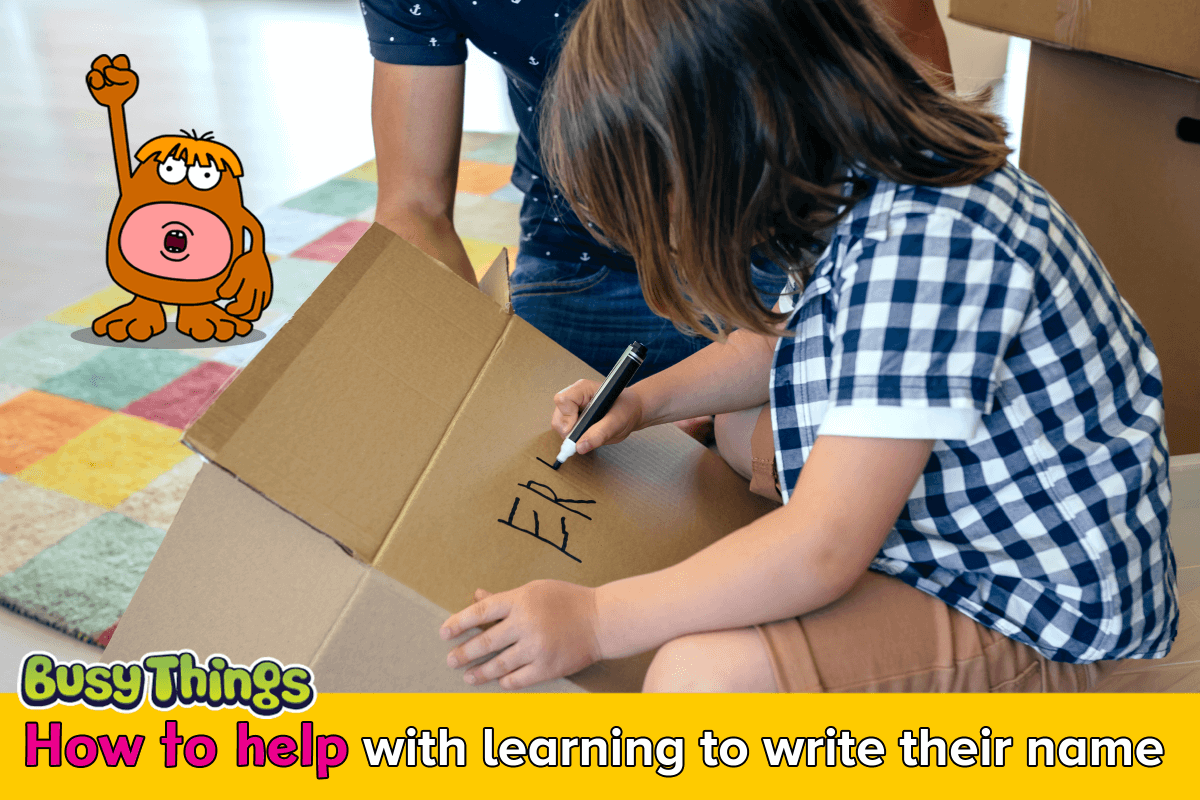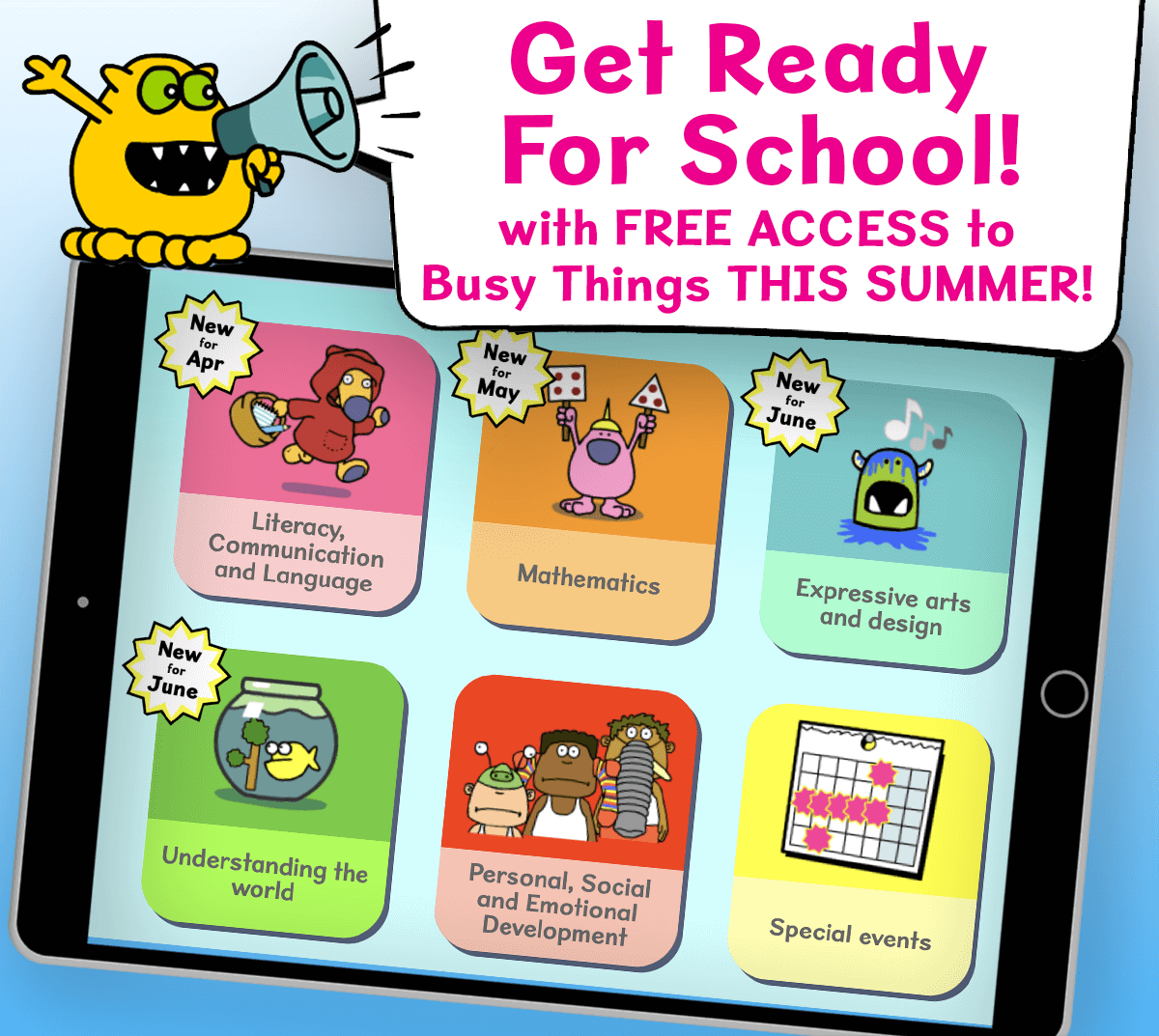How to help children learn to write their name

One of the key things that children are asked to learn before starting school is to recognise their name and to start to write their name. We’re here to help you make this fun and easy with lots of name learning activity ideas!
There are quite a few stages involved in children learning to write their name and this starts long before they pick up a pencil! Indeed, some children might not have the muscle strength or fine motor skills to control a pencil as yet so it’s important to work on those skills too with lots of painting, play dough, threading beads etc.
Keep reading for fun ideas to help children learn to write their name:
- Help them recognise their name
- Learn about the letters in their name
- Get the letters in the right order
- Practise writing their name
Don’t miss out on our FREE Starting School Guest Account giving you free access to ALL our award-winning earl years games and activities this summer!
It’s important to remember, children all learn in different ways and at different speeds so please don’t put any pressure or expectations on them or yourselves. Just have fun playing the activities together, learning WILL be happening!
1. Name recognition ideas
Firstly, we need to encourage children to recognise their name as a whole – the length of the word and the shape that the letters make together. So expose them to it as much as possible and display it everywhere you can!
Label their belongings – clothes, books, lunch boxes etc.
You could create and decorate a bedroom door sign together. In fact, we’ve just added a new name plate maker resource to Busy Things that would be perfect for the job!
Write their name on any artwork they do.
Write out or print a selection of names, people that they know or their toys names (perhaps do a teddy bears picnic where they all have place settings). Can they spot their name in the mix?
How about making place settings for the dinner table? Give them the important responsibility of setting them out each day.
You could make a family photo album together. Print out some name labels for them to add to the photos.
2. Learn about the letters in their name
Now that we can recognise our name as a whole, it’s time to look at the letters within that name.
Whenever you see the letters in their name on signs or on food packets be sure to point it out. Say ‘Look at this E, your name starts with an E’ or ‘Look, this word has an ‘a’ in it, your name has an ‘a’ in it’ etc. Do try to use the phonetic sounds as well as letter names – you can learn more about phonics here.
It’s important to try to get children to form letters in the right way from the start as it can be difficult to correct later, letter formation rhymes are useful for this.
Go big and walk the letters! Draw huge letters in chalk on the floor and talk them through the route around the letters. Why not make it part of an obstacle course.
Make 3D letters using lego bricks, cars, teddies – anything!
Write their name in large letters across a sheet of paper. Get all the senses (Sight, Sound, Smell, Taste, and Touch) involved by encouraging them to use different materials to cover and form the lines of each letter e.g.
- Get them to trace over your letters with their finger. (You could try different materials e.g. sandpaper or fabric to involve different senses)
- Stick on small stickers, beads or flowers petals following the lines of the letter shapes. (This will also develops fine motor skills)
- Form the letters in playdough (also developing finger strength)
- Put greaseproof paper over the named paper and use food to follow the letters or paint with chocolate spread or icing
Try out the letter formation games on Busy Things, including our new name tracing game. It’s one of many games included in our free Starting School Guest account this summer! Read on for your login details.
3. Getting the letters in the right order
So, now that we can recognise our name and the letters within it. Can we now get them in the right order?
Write down their name and cut each letter into a different square – or use fridge magnets or bath letters (do try to use a capital first letter and lower case for the rest though). Start by laying them out in order and just taking out a couple of the letters. Can they put them back in the right place? Work up to scrambling all the letters, for them to make up their name from scratch.
You could make this more interesting by turning it into more of a game – hide the letter tiles in your house or garden. They have to find them and arrange them in the right order.
Play buried treasure! Print or write out lots of words using the letters in their name (they don’t have to be real words!) and bury them along with lots of the right spellings in a tub of sand. Can they tell you which is their name and which are fools gold?
Time for some cheerleading! Do they know what letter comes next in their name? ‘Give me an A’, ‘Given me an… ?’ … ‘What do you get? XYZ!!!’ You could make this so much fun with a dance routine, props and everything, they’ll love it!
4. Learn to write their name
Once they can recognise their name and they are familiar with the letters, it is finally time to have a go at learning to write their name with a pencil.
Start with big letters and get smaller over time.
Get them to write over your writing or draw the letters out in dots for them to join up, working up to try writing on their own. You can use our name letter formation worksheets for this too.
Keep practising, use of lots encouragement and remember that children will be at different stages with their pencil grip so keep working on those fine motor skills!
Starting school this year?

If your child is starting school this year, make sure to take advantage of our FREE Get Ready for school guest account!
We want to help children to have the very best experience starting school! So we’re offering FREE access to ALL of our award-winning early years games and activities this summer, to boost their skills and confidence ready for September!
We hope our How to help children to learn to write their name blog has been useful! Please do let us know what you think in the comments and if you have any further ideas to share…
You might also be interested in our stating school preparation guides:
Starting School: Hints and Tips
Your First Day at School Checklist
Is Your Child Ready for School, Emotionally and Socially?